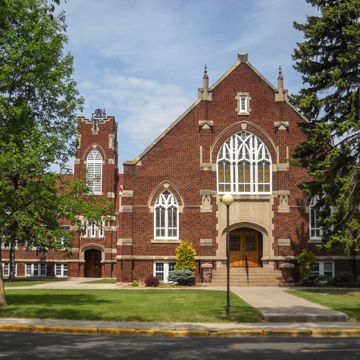The real and symbolic focus of campus life at Jamestown College is the Voorhees Chapel, named for Elizabeth Voorhees of Clinton, New Jersey, who financed the building. The cruciform Collegiate Gothic chapel was designed by the college’s president, Barend H. Kroeze, who had studied architecture at the University of Michigan. Although stylistically out of fashion when built, it was nonetheless functionally innovative in the variety and flexibility of spaces, containing a theater, commons, classrooms, and a sanctuary with seating for seven hundred. The exterior walls are common bond dark red brick manufactured by the St. Louis Hydraulic Press Brick Company. Gabled roofs on the main block, transept, and wing are covered in red slate. Pediment dormers with quatrefoil tracery ornament the wing, and a pair of five-stage buttresses topped by finials flanks the entrance, with shorter versions along the side elevations. The arched entrance is in the battlemented bell tower. Inside, the roof framing incorporates medieval-type components such as hammer beams and braces, pendant posts, corbels, and arch timbers with triangular headings carved in foils. The Gothic theme is reinforced in the leaded- and stained glass windows, traceried brass door hardware, and escutcheons patterned in triple arches.
You are here
Voorhees Chapel
If SAH Archipedia has been useful to you, please consider supporting it.
SAH Archipedia tells the story of the United States through its buildings, landscapes, and cities. This freely available resource empowers the public with authoritative knowledge that deepens their understanding and appreciation of the built environment. But the Society of Architectural Historians, which created SAH Archipedia with University of Virginia Press, needs your support to maintain the high-caliber research, writing, photography, cartography, editing, design, and programming that make SAH Archipedia a trusted online resource available to all who value the history of place, heritage tourism, and learning.


